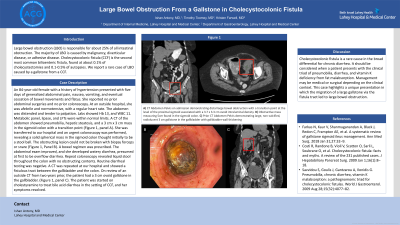Monday Poster Session
Category: Colon
P2042 - Large Bowel Obstruction From a Gallstone in Cholecystocolonic Fistula
Monday, October 28, 2024
10:30 AM - 4:00 PM ET
Location: Exhibit Hall E

Has Audio

Ishan Antony, MD
Lahey Hospital and Medical Center
Burlington, MA
Presenting Author(s)
Ishan Antony, MD, Timothy Toomey, MD, Kristen Farwell, MD
Lahey Hospital and Medical Center, Burlington, MA
Introduction: Large bowel obstruction (LBO) is responsible for about 25% of all intestinal obstruction. The majority of LBO is caused by malignancy, diverticular disease, or adhesive disease. Cholecystocolonic fistula (CCF) is the second most common bilioenteric fistula, found at about 0.1% of cholecystectomies and 0.1-0.5% of autopsies. We report a rare case of LBO caused by a gallstone from a CCF.
Case Description/Methods: An 84-year-old female with a history of hypertension presented with five days of generalized abdominal pain, nausea, vomiting, and eventual cessation of bowel movements and flatus. She reported no prior abdominal surgeries and no prior colonoscopy. At an outside hospital, she was afebrile and normotensive, with a regular heart rate. The abdomen was distended and tender to palpation. Labs showed Hb 13, and WBC 11. Metabolic panel, lipase, and LFTs were within normal limits. A CT of the abdomen showed pneumobilia, hepatic steatosis, and a 3 cm x 3 cm mass in the sigmoid colon with a transition point (Figure 1, panel A). She was transferred to our hospital and an urgent colonoscopy was performed, revealing a solid spherical mass in the sigmoid colon thought initially to be a stool ball. The obstructing lesion could not be broken with biopsy forceps or snare (Figure 1, Panel B). A bowel regimen was prescribed. The abdominal exam improved, and she developed watery diarrhea, presumed at first to be overflow diarrhea. Repeat colonoscopy revealed liquid stool throughout the colon with no obstructing contents. Routine diarrheal testing was negative. A CT was repeated at our hospital and showed a fistulous tract between the gallbladder and the colon. On review of an outside CT from two years prior, the patient had a 3 cm ovoid gallstone in the gallbladder. (Figure 1, panel C). The patient was started on cholestyramine to treat bile acid diarrhea in the setting of CCF, and her symptoms resolved.
Discussion: Cholecystocolonic fistula is a rare cause in the broad differential for chronic diarrhea. It should be considered when a patient presents with the clinical triad of pneumobilia, diarrhea, and vitamin K deficiency from fat malabsorption. Management may be medical or surgical depending on the clinical context. This case highlights a unique presentation in which the migration of a large gallstone via the fistula tract led to large bowel obstruction.

Disclosures:
Ishan Antony, MD, Timothy Toomey, MD, Kristen Farwell, MD. P2042 - Large Bowel Obstruction From a Gallstone in Cholecystocolonic Fistula, ACG 2024 Annual Scientific Meeting Abstracts. Philadelphia, PA: American College of Gastroenterology.
Lahey Hospital and Medical Center, Burlington, MA
Introduction: Large bowel obstruction (LBO) is responsible for about 25% of all intestinal obstruction. The majority of LBO is caused by malignancy, diverticular disease, or adhesive disease. Cholecystocolonic fistula (CCF) is the second most common bilioenteric fistula, found at about 0.1% of cholecystectomies and 0.1-0.5% of autopsies. We report a rare case of LBO caused by a gallstone from a CCF.
Case Description/Methods: An 84-year-old female with a history of hypertension presented with five days of generalized abdominal pain, nausea, vomiting, and eventual cessation of bowel movements and flatus. She reported no prior abdominal surgeries and no prior colonoscopy. At an outside hospital, she was afebrile and normotensive, with a regular heart rate. The abdomen was distended and tender to palpation. Labs showed Hb 13, and WBC 11. Metabolic panel, lipase, and LFTs were within normal limits. A CT of the abdomen showed pneumobilia, hepatic steatosis, and a 3 cm x 3 cm mass in the sigmoid colon with a transition point (Figure 1, panel A). She was transferred to our hospital and an urgent colonoscopy was performed, revealing a solid spherical mass in the sigmoid colon thought initially to be a stool ball. The obstructing lesion could not be broken with biopsy forceps or snare (Figure 1, Panel B). A bowel regimen was prescribed. The abdominal exam improved, and she developed watery diarrhea, presumed at first to be overflow diarrhea. Repeat colonoscopy revealed liquid stool throughout the colon with no obstructing contents. Routine diarrheal testing was negative. A CT was repeated at our hospital and showed a fistulous tract between the gallbladder and the colon. On review of an outside CT from two years prior, the patient had a 3 cm ovoid gallstone in the gallbladder. (Figure 1, panel C). The patient was started on cholestyramine to treat bile acid diarrhea in the setting of CCF, and her symptoms resolved.
Discussion: Cholecystocolonic fistula is a rare cause in the broad differential for chronic diarrhea. It should be considered when a patient presents with the clinical triad of pneumobilia, diarrhea, and vitamin K deficiency from fat malabsorption. Management may be medical or surgical depending on the clinical context. This case highlights a unique presentation in which the migration of a large gallstone via the fistula tract led to large bowel obstruction.

Figure: Figure 1: A) CT Abdomen Pelvis on admission demonstrating distal large bowel obstruction with a transition point at the level of the proximal sigmoid associated with a 3.7 x 3.3 cm ovoid intraluminal density. B) Obstructive mass measuring 5cm found in the sigmoid colon. C) Prior CT Abdomen Pelvis demonstrating large, non-calcified, radiolucent 3 cm gallstone in the gallbladder with gallbladder wall thickening
Disclosures:
Ishan Antony indicated no relevant financial relationships.
Timothy Toomey indicated no relevant financial relationships.
Kristen Farwell indicated no relevant financial relationships.
Ishan Antony, MD, Timothy Toomey, MD, Kristen Farwell, MD. P2042 - Large Bowel Obstruction From a Gallstone in Cholecystocolonic Fistula, ACG 2024 Annual Scientific Meeting Abstracts. Philadelphia, PA: American College of Gastroenterology.
